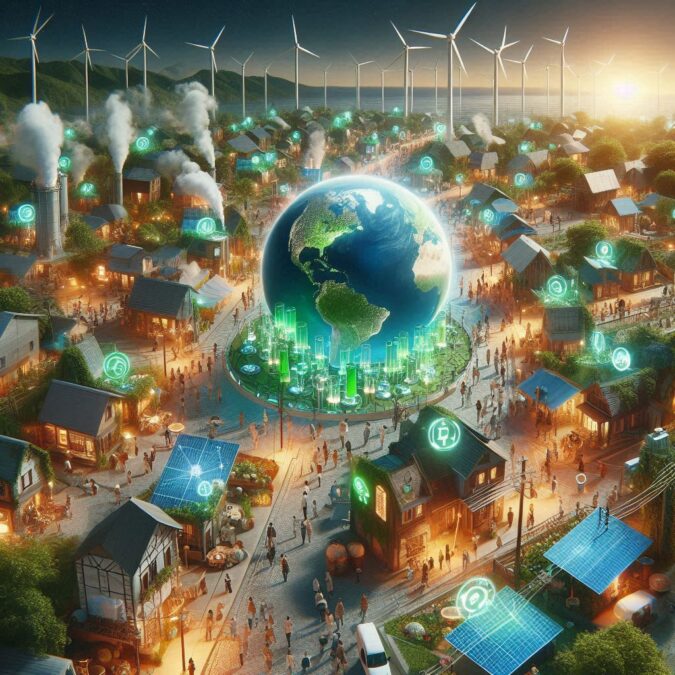
Hydrogen Myths
February 23, 2024
Why Hydrogen Cars Will Beat Gas Cars and EVs?
September 30, 2024Hydrogen: The Key to Unlocking Green Energy Microgrids

Imagine a world where communities are powered by clean, renewable energy, and energy systems are robust against the disruptions of climate change. Hydrogen is making this vision a reality through green microgrids. This article will explore how microgrids can produce, store, and utilize hydrogen, highlighting innovative technologies and real-world applications.
You can dive deeper into this topic on our Sept 23 webcast at NYC Climate Week. To join, SIGN UP.
Understanding Green Microgrids and Hydrogen
A green microgrid is a local energy system that generates power from renewable energy sources such as solar or wind. These systems often include energy storage solutions, like batteries, to ensure a stable energy supply. Green microgrids can operate autonomously or connect to the larger grid, providing energy resilience and reducing carbon footprint.
Hydrogen stands out as a clean energy carrier. It can produce electricity through fuel cells, emitting only water vapor. Unlike solar and wind, hydrogen can be stored and transported, addressing the intermittency issues associated with other renewables. This makes hydrogen an essential component in the transition to sustainable energy systems.
Hydrogen Production for Microgrids
Methods of Hydrogen Production
Hydrogen can be produced through several methods, the most prominent being electrolysis, where water is split into hydrogen and oxygen using electricity. The hydrogen produced is entirely green when this electricity comes from renewable sources. Advances in electrolyzer technology, which facilitate this process, are making green hydrogen more cost-effective and scalable.
Producing hydrogen through electrolysis powered by renewable energy minimizes greenhouse gas emissions, significantly reducing the environmental impact compared to fossil fuels. Economically, hydrogen production costs are decreasing, making it competitive with traditional energy sources. According to a report by the Hydrogen Council, green hydrogen production costs could fall by 50% by 2030.
Hydrogen Storage Solutions
Current Methods and Technologies
Storing hydrogen efficiently and safely is crucial for its use in microgrids. Common storage methods include:
- Compressed Gas Storage: Hydrogen is stored under high pressure in gas cylinders.
- Liquid Hydrogen Storage: Hydrogen is cooled to cryogenic temperatures and stored as a liquid.
- Metal Hydrides: Hydrogen is absorbed and released from metal alloys, offering high density storage.
Safety and Efficiency Challenges
Hydrogen storage poses challenges, such as high costs and safety concerns associated with its flammability. Part of the solution lies in education – in general, gasoline is similarily dangerous chemical, but as most of us are used in handling it, we rarely think of associated safety concerns.
However, advancements in storage technology, like improved materials for tank designs, are enhancing both safety and efficiency. For example, researchers at the Pacific Northwest National Laboratory have developed advanced hydrogen storage materials that enhance safety without compromising capacity.
Utilization of Hydrogen in Green Microgrids
Hydrogen can be used to generate electricity through fuel cells, converting the chemical energy of hydrogen into electricity with water vapor as the only byproduct. This integration supports the decarbonization of electricity and heat production in microgrids. Hydrogen can also be combined with other renewables, creating hybrid systems that ensure continuous power supply.
Several real-world applications showcase the success of hydrogen microgrids:
- Japan: The town of Namie has implemented a hydrogen-based microgrid, enabling energy independence and resilience. This project leverages local renewable energy to produce hydrogen, powering homes and businesses.
- Germany: The H2ORIZON project integrates hydrogen storage with renewable energy to provide an uninterrupted power supply. This initiative has proven successful in stabilizing the local energy grid.
- Australia: In South Australia, the Hydrogen Park South Australia (HyP SA) produces green hydrogen for blending with natural gas and powering microgrids. This project illustrates the versatility and practical application of hydrogen in diverse settings.
Economic Viability and Benefits
While the initial investment in hydrogen infrastructure may be higher, the long-term savings and environmental benefits are substantial. Hydrogen production costs are decreasing, making it an economically competitive alternative to fossil fuels. Governments and private sector are providing financial incentives and support mechanisms, further driving down costs.
The hydrogen economy has the potential to create numerous jobs, from production and storage to distribution and maintenance. For instance, according to the Hydrogen Council, hydrogen could create 30 million jobs globally by 2050, contributing significantly to economic growth. Countries leading in hydrogen technology, like Germany and Japan, are already seeing economic benefits from this industry.
Enhancing Energy Security through Hydrogen Microgrids
Hydrogen microgrids reduce reliance on fossil fuels, diversifying energy sources and enhancing energy security. This is particularly important for countries with limited fossil fuel resources – like post-oil shale Estonia – as it helps mitigate the risks associated with energy imports and price volatility.
Hydrogen microgrids are crucial for disaster resilience, providing a reliable energy source during emergencies. In disaster-prone areas, hydrogen-powered microgrids can maintain energy supplies, ensuring essential services remain operational. For example, in Puerto Rico, microgrids powered by renewable energy and hydrogen have been implemented to enhance energy resilience after the devastation caused by Hurricane Maria.
Challenges and Barriers to Adoption
While hydrogen microgrids hold great promise, several technical challenges need to be addressed, such as improving electrolyzer efficiency, enhancing storage solutions, and reducing production costs. Innovations and investments in research and development are critical to overcoming these hurdles and realizing the full potential of hydrogen microgrids.
Resistance from stakeholders and policy barriers can impede the adoption of hydrogen microgrids. Common resistance points include the high initial costs and safety concerns. However, robust government policies, public-private partnerships, and educational initiatives can address these challenges. For example, the European Union’s Hydrogen Strategy aims to stimulate the development of hydrogen infrastructure through financial support and regulatory frameworks.
The Path Forward: Scaling Hydrogen Microgrids Globally
Global deployment of hydrogen microgrids requires addressing regional challenges, such as varying geographic and climatic conditions. Adapting hydrogen technologies to local contexts ensures their effectiveness and sustainability. Collaborative efforts among governments, industries, and research institutions are essential for successful regional implementation.
Educating the public and stakeholders about the benefits of hydrogen microgrids is crucial for their acceptance and integration. Awareness campaigns and informational resources can highlight the environmental and economic advantages, addressing misconceptions and building support for hydrogen-based solutions.
The next decade is crucial for the growth of hydrogen microgrids. Projections indicate significant advancements in technology, cost reductions, and increased adoption rates. According to the International Energy Agency (IEA), hydrogen production capacity could grow by 300% by 2030, driven by supportive policies and technological innovations.
Hydrogen possesses the transformative potential to create sustainable and resilient energy systems through green microgrids. By producing, storing, and utilizing hydrogen, we can reduce reliance on fossil fuels, enhance energy security, and drive the future of clean, sustainable energy globally. While challenges remain, ongoing innovations and collaborative efforts are paving the way for a greener, more sustainable world.
Featured picture is made with Designer. Powered by DALL·E 3.



